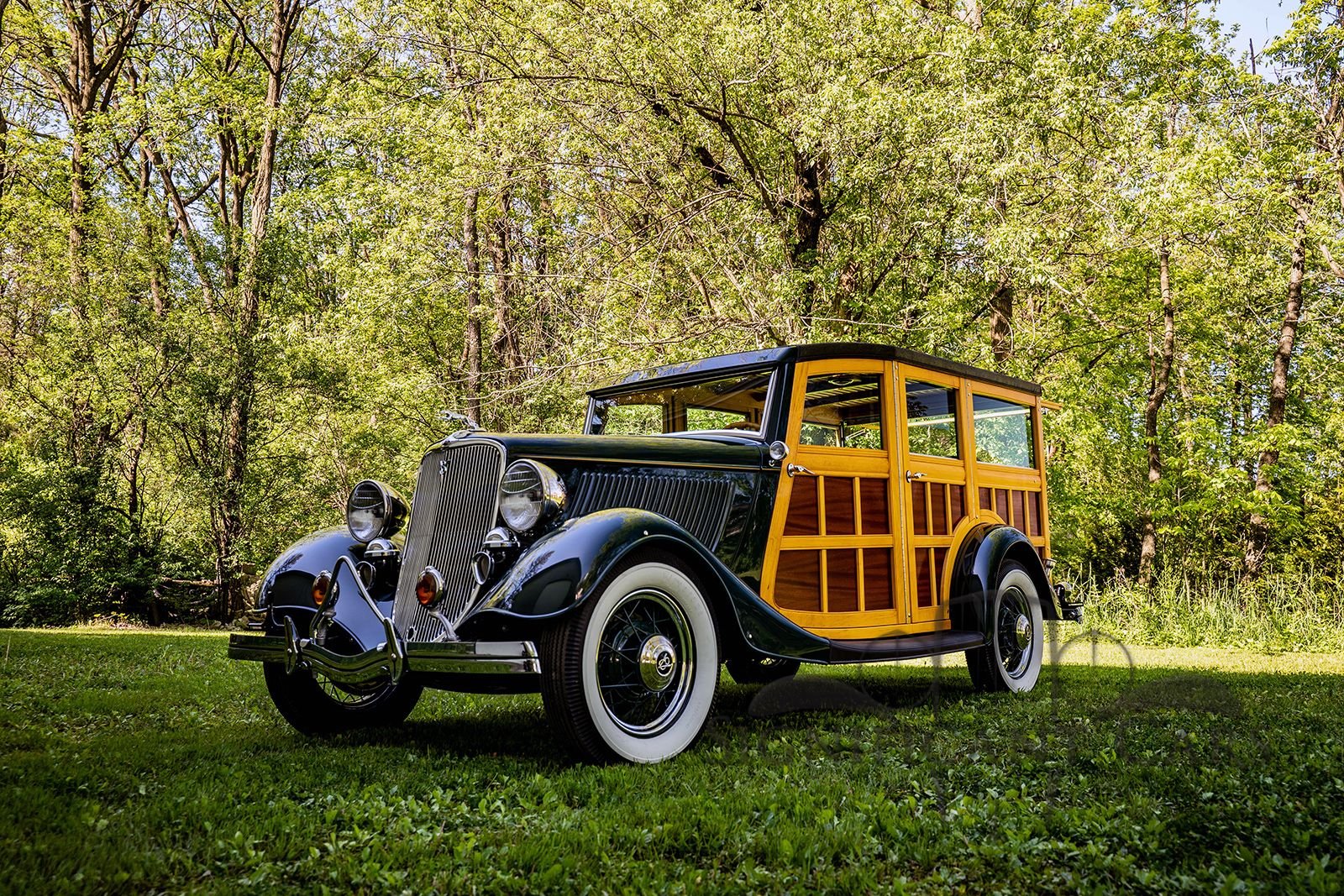Drivetrain
Chassis
Body
1933 Ford Woody Wagon Freshly Restored Exceptional Quality
Rather than just updating the Model A, Ford launched a completely new vehicle for 1932. The V8 was marketed as the Model 18 in its initial year, but was commonly known as the Ford V8. It had the new flathead V8engine. The Model 18 was the first low-priced, mass-marketed car to have a V8 engine, an important milestone in Automotive industry in the United States. The 221 cu in V8 was rated at 65 hp, but power increased significantly with improvements to the carburetor and ignition in succeeding years. The V8 was more popular than the four-cylinder, which was essentially a variant of the Model A engine with improvements to balancing and lubrication.
Model B was derived with as few technical changes as possible to keep cost low. Other than the engine, and badging on headlamp support bar (later: grille) and hub caps, it was virtually indistinguishable from the V-8. Its intention was to be a price leader, and as it offered more than the popular Model A, this should have been a winning formula. In fact, the new and only slightly more expensive V-8 stole the show, and finally made it obsolete. The V8 engine was previously exclusive to Lincoln products, which in 1932 switched to V12 engines only.
Although there is a certain visual similarity with the predecessor Model A, the car was new. While the Model A has a simple frame with two straight longitudinal members, the new car got a longer wheelbase, and an outward curved, double-dropped chassis. In both models the fuel tank is relocated from the cowl as in Model A and late Model T, where its back formed the dash, to the lower rear of the car, as is typical in modern vehicles; thus requiring Ford to include an engine-driven fuel pump rather than rely on gravity feed. While the V8 was developed from scratch, the B just had an improved four-cylinder Model A engine of 201 cu in displacement producing 50 horsepower.
When the Model 40 and the new B were introduced February 9, 1933, revisions of the car were substantial, especially considering how important the 1932 change had been. For its second year, the wheelbase was stretched, from 106 in to 112 in on a new crossmember frame. The grille was revised, gaining a pointed forward slope at the bottom which resembled either a spade, a Medieval shield, or possibly the 1932 Packard Light Eight in general outline anyway. Both the grille and hood louvers curved down and forward. The overall design and grille were inspired by the English Ford Model Y. Streamlining was further accentuated by the new hood which now covered the cowl, giving an impression of more length. In addition, there were more rounded and skirted fenders and new, elegantly bowed bumpers. Headlamp support bars were no longer in use, and there were new wire wheels. The cars got a new dashboard with instruments set in an oval insert in front of the driver. There was a glove box on the passenger side. Closed Deluxe models received heavy DI-NOC woodgraining on dash and window frames, and there were deeper seat cushions.
There were 10 body styles (14 if standard and Deluxe trim levels are counted separately). Now, all were available for V-8s and the Model B, which thus got Deluxe models, too. Convertible Coupes and Victoria came in Deluxe trim only, and the most expensive car in the line, the "woody", as a Standard only. It cost US$590 with the four-cylinder engine. The cars gained about 3 percent in weight, compensated for with more powerful engines, as on the V-8 with its 15 percent increase in power.
This exceptional example is freshly restored, and is arguably one of the finest of it's kind. Restored with no expense spared, it was a complete nut and bolt rotisserie restoration by all high end, well known restorers. Featuring a Push Out Windshield, Roll-up front windows and sliding rear windows with tinted glass, Forest Green base/clear paint, 12 volt electric system, Coke Cooler battery box, Clock Shifter knob, Custom Made Wood Steering Wheel, Rear Bumper, Stainless Steel Wheel Trim Rings, Spare tire with original Factory Lock, Unities Spotlights, and an Original Dunsford under hood tool box, this car has it all!
The Hercules Wood Body was restored by Hennsler Refinishing using hand rubbed Spar Varnish. The All Steel body was restored by Hopper Stat Metal Work, and the Paint was done by Suicide Axle Hot Rods.
The Flathead V8 was rebuilt by H&H Flatheads of CA, featuring Red's Headers, Eddy Meyer Performance Heads, Dual Carb Manifold, and Air Cleaner, fronted by a Brassworks Radiator. The 3 Speed was rebuilt by Mac Van Pelt and the 2 Speed Columbia by Dan Krehbell. A Ford F-1 Steering Box built by Cliff Helling and 4 Wheel Hydraulic Brakes by the Early V8 Shop were also added.
Custom Gauges from R&S Gauges and an EletroTech Altered Factory Radio, with an Engine Turned Dash by Skip Barber, perfectly accenuate the Addison Auto Trim Interior. All brightwork was plated by the Finishing Touch of Chicago.
In short this Woody was restored by the best and most respected restorers and specialist in the Country.
And here it is, the most spectacular example we have ever seen, offered for the first time, fresh from restoration, having not been shown previously, and ready for you to go collect a bunch of Awards with!
If you are looking for the Finest Early Ford V8 Woody you can find, look no further.






























































